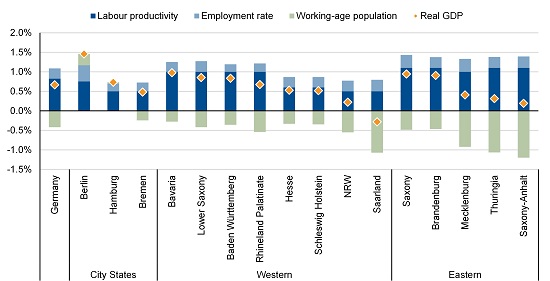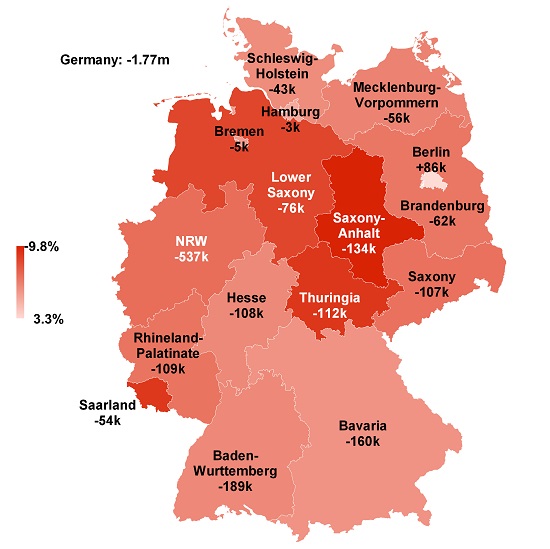Announcements
Drinks

Germany: uneven demographic trends weigh on medium-term growth as near-term downturn worsens
By Julian Zimmermann, Eiko Sievert and Jakob Suwalski
Sluggish growth in Germany (AAA/Stable) has multiple sources, including stagnant private consumption, the downturn in the construction sector given higher interest rates, cost pressures in energy-intensive industry, lower government consumption and relatively weak exports.
We have lowered our projection for this year and now expect a real GDP contraction of 0.4% compared with a contraction of 0.1% in our July forecast. Growth will still rebound modestly to 1% next year on a pick-up in government spending and improved household consumption, helped by diminishing inflation and a cooling but still strong labour market. This does not challenge Germany’s credit rating in the near term, as government and business steer the country through the slowdown.
Still, meeting longer-term credit challenges, particularly raising the economy’s growth potential, requires close attention by the federal government and the 16 federal states, the Länder. Without further structural reform, we estimate Germany’s annual growth potential will average a modest 0.7% until 2030, significantly below all other AAA-rated peers.
The main drag on growth is the country’s ageing society, notably the decline in the working-age population (WAP, people aged 15-66), which contributes to skills shortages and productivity losses. Looking at the 16 Länder, only the city-state Berlin (AAA/Stable) will benefit from a positive contribution to economic growth from trends in its WAP between 2024 and 2030 (see Figure 1).
Figure 1: Germany’s uneven demographic challenge: medium-term growth drivers by Land
Annual % change, average 2024-30

Note: Real GDP growth is estimated as: i) historical trends in labour productivity (real GDP per person employed), adjusted for assumptions of ifo Dresden 2019; ii) historical trends in the employment rate, adjusted for assumptions in Destatis 2020 and BMF 2020; and iii) working-age population projections from Destatis’ 15th coordinated population projection (Variant 2, i.e. moderate net migration). Source: Destatis, Statistische Ämter des Bundes und der Länder, Federal Ministry of Finance, ifo Dresden, Scope Ratings
Attracting foreign workers is crucial to address labour shortage
Germany’s WAP is expected to decline to around 54m by 2030, compared with almost 56m in 2022, equivalent to a decline of around 221,000 a year on average. These projections already include the recent influx of refugees from Ukraine, amounting to around 1m people who, according to Mediendienst Integration, have dispersed fairly evenly across the Länder.
The primary strategy for sustaining the labour supply is to attract qualified foreign workers, alongside encouraging more women and the elderly into (full-time) work. Recent reform eases immigration hurdles for non-EU workers with the aim of attracting around 75,000 a year.
However, Germany needs further initiatives as current reforms are not enough to compensate for the shrinking pool of domestic workers. Ageing and emigration among working-age Germans has led to a structurally greater share of non-Germans in the labour supply. In a benign, high migration scenario with 400,000 immigrants per year (on a net basis, versus 290,000 in the baseline scenario), we estimate that potential growth could rise to nearly 1% a year.
Contrasting demographics influence economic outlook for the Länder
Demographic and migration trends will not play out equally among the Länder, with repercussions for regional growth and public finances, including the financing of pensions for state-level civil servants. Given their large weight in overall GDP, growth in North-Rhine Westphalia (share of 21%), Bavaria (AAA/Stable, 19%) and Baden-Württemberg (AAA/Stable, 15%), will be particularly important for Germany’s outlook.
Figure 2: Shrinking workforce presents demographic challenge for Germany’s Länder
Change in working-age population 2022-2030 in ‘000s; % change colour-coded

Source: Destatis‘ 15th coordinated population projection (Variant 2, i.e. moderate net migration), Scope Ratings
Only Berlin will have a higher WAP in 2030 than in 2022 (+3.3%), while the other 15 are set for smaller WAPs. Saxony-Anhalt faces the steepest decline, with its WAP in 2030 almost 10% smaller than in 2022.
Boosted by demographics, we project Berlin to be the fastest-growing regional economy in Germany, with an average real growth rate of 1.5%, leaving its economy around 11% larger in 2030 than it was at the end of 2023. In contrast, Saarland will experience an average decline in real economic activity of 0.3%, leaving its economy 2% smaller by 2030.
Greater focus needed on job creation and boosting productivity
Beyond demographic dynamics, trends in labour productivity and employment are important drivers of the Länder’s growth potential. For example, employed persons in Berlin were 6% more productive in 2022 than they were in 2015. In contrast, labour productivity declined by around 3% in Saarland in the same period, highlighting the structural challenges different regions face.
In Germany, overall economic policy lies predominantly with the central government, but the Länder have their own economic programmes for which they also rely on their development banks. These will provide around 20-30% more funding in coming years compared to pre-pandemic activity for start-ups and small businesses among others. Smarter spending on education, one of the Länder’s biggest budget items, could also deliver productivity gains through commercialisation of university research and closer cooperation with business.
Growth pressures have limited credit implications for Länder
Despite these contrasting growth prospects, we expect the impact to be limited on Länder’s credit quality. Germany’s highly integrated framework, including a predictable and extensive fiscal-equalisation mechanism that aligns relative taxing powers in the Länder, ties their credit ratings to the AAA-ratings of the federal government.
However, Länder credit quality is still exposed to risks such as rising interest rates, rigid expenditure structures and increasing spending and investment needs related to the net-zero transition. Given close integration with the sovereign, effective and coordinated reforms are crucial to tackle the structural challenges faced by the country.
Make sure you stay up to date with Scope’s ratings and research by signing up to our newsletters across credit, ESG and funds. Click here to register.





